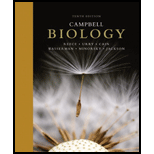
Campbell Biology (10th Edition)
10th Edition
ISBN: 9780321775658
Author: Jane B. Reece, Lisa A. Urry, Michael L. Cain, Steven A. Wasserman, Peter V. Minorsky, Robert B. Jackson
Publisher: PEARSON
expand_more
expand_more
format_list_bulleted
Concept explainers
Question
Chapter 55, Problem 2TYU
Summary Introduction
Introduction: The total fixation of energy by photosynthesis is referred to as gross primary production (GPP). The proportion which remains after respiration loss is termed Net primary productivity (NPP). It depicts the actual rate of the new biomass, which is present for heterotrophs consumption.
Expert Solution & Answer
Want to see the full answer?
Check out a sample textbook solution
Students have asked these similar questions
What is the structure and function of Eukaryotic cells, including their organelles? How are Eukaryotic cells different than Prokaryotic cells, in terms of evolution which form of the cell might have came first? How do Eukaryotic cells become malignant (cancerous)?
What are the roles of DNA and proteins inside of the cell? What are the building blocks or molecular components of the DNA and proteins? How are proteins produced within the cell? What connection is there between DNA, proteins, and the cell cycle? What is the relationship between DNA, proteins, and Cancer?
Why cells go through various types of cell division and how eukaryotic cells control cell growth through the cell cycle control system?
Chapter 55 Solutions
Campbell Biology (10th Edition)
Ch. 55.1 - Why is the transfer of energy in an ecosystem...Ch. 55.1 - WHAT IF? You are studying nitrogen cycling on the...Ch. 55.1 - MAKE CONNECTIONS Use the second law of...Ch. 55.2 - Why is only a small portion of the solar energy...Ch. 55.2 - How can ecologists experimentally determine the...Ch. 55.2 - MAKE CONNECTIONS Explain how nitrogen and...Ch. 55.3 - If an insect that eats plant seeds containing 100...Ch. 55.3 - Prob. 2CCCh. 55.3 - Prob. 3CCCh. 55.4 - DRAW IT For each of the four biogeochemical...
Ch. 55.4 - Why does deforestation of a watershed increase the...Ch. 55.4 - WHAT IF? Why is nutrient availability in a...Ch. 55.5 - Prob. 1CCCh. 55.5 - Prob. 2CCCh. 55 - Considering the second law of thermodynamics,...Ch. 55 - Prob. 55.2CRCh. 55 - Why would runners hove a lower production...Ch. 55 - If decomposers usually grow faster and decompose...Ch. 55 - In preparing a site for surface mining and later...Ch. 55 - Which of the following organisms is incorrectly...Ch. 55 - Prob. 2TYUCh. 55 - The discipline that applies ecological principles...Ch. 55 - Level 2: Application/Analysis 4. Nitrifying...Ch. 55 - Which of the following has the greatest effect on...Ch. 55 - Prob. 6TYUCh. 55 - Which of the following would be considered an...Ch. 55 - Prob. 8TYUCh. 55 - Level 3: Synthesis/Evaluation 9. DRAW IT (a) Draw...Ch. 55 - Prob. 10TYUCh. 55 - Prob. 11TYUCh. 55 - WRITE ABOUT A THEME: ENERGY AND MATTER...Ch. 55 - Prob. 13TYU
Knowledge Booster
Learn more about
Need a deep-dive on the concept behind this application? Look no further. Learn more about this topic, biology and related others by exploring similar questions and additional content below.Similar questions
- In one paragraph show how atoms and they're structure are related to the structure of dna and proteins. Talk about what atoms are. what they're made of, why chemical bonding is important to DNA?arrow_forwardWhat are the structure and properties of atoms and chemical bonds (especially how they relate to DNA and proteins).arrow_forwardThe Sentinel Cell: Nature’s Answer to Cancer?arrow_forward
- Molecular Biology Question You are working to characterize a novel protein in mice. Analysis shows that high levels of the primary transcript that codes for this protein are found in tissue from the brain, muscle, liver, and pancreas. However, an antibody that recognizes the C-terminal portion of the protein indicates that the protein is present in brain, muscle, and liver, but not in the pancreas. What is the most likely explanation for this result?arrow_forwardMolecular Biology Explain/discuss how “slow stop” and “quick/fast stop” mutants wereused to identify different protein involved in DNA replication in E. coli.arrow_forwardMolecular Biology Question A gene that codes for a protein was removed from a eukaryotic cell and inserted into a prokaryotic cell. Although the gene was successfully transcribed and translated, it produced a different protein than it produced in the eukaryotic cell. What is the most likely explanation?arrow_forward
- Molecular Biology LIST three characteristics of origins of replicationarrow_forwardMolecular Biology Question Please help. Thank you For E coli DNA polymerase III, give the structure and function of the b-clamp sub-complex. Describe how the structure of this sub-complex is important for it’s function.arrow_forwardMolecular Biology LIST three characteristics of DNA Polymerasesarrow_forward
arrow_back_ios
SEE MORE QUESTIONS
arrow_forward_ios
Recommended textbooks for you

 Human Biology (MindTap Course List)BiologyISBN:9781305112100Author:Cecie Starr, Beverly McMillanPublisher:Cengage Learning
Human Biology (MindTap Course List)BiologyISBN:9781305112100Author:Cecie Starr, Beverly McMillanPublisher:Cengage Learning Biology: The Dynamic Science (MindTap Course List)BiologyISBN:9781305389892Author:Peter J. Russell, Paul E. Hertz, Beverly McMillanPublisher:Cengage Learning
Biology: The Dynamic Science (MindTap Course List)BiologyISBN:9781305389892Author:Peter J. Russell, Paul E. Hertz, Beverly McMillanPublisher:Cengage Learning Biology (MindTap Course List)BiologyISBN:9781337392938Author:Eldra Solomon, Charles Martin, Diana W. Martin, Linda R. BergPublisher:Cengage Learning
Biology (MindTap Course List)BiologyISBN:9781337392938Author:Eldra Solomon, Charles Martin, Diana W. Martin, Linda R. BergPublisher:Cengage Learning Concepts of BiologyBiologyISBN:9781938168116Author:Samantha Fowler, Rebecca Roush, James WisePublisher:OpenStax College
Concepts of BiologyBiologyISBN:9781938168116Author:Samantha Fowler, Rebecca Roush, James WisePublisher:OpenStax College


Human Biology (MindTap Course List)
Biology
ISBN:9781305112100
Author:Cecie Starr, Beverly McMillan
Publisher:Cengage Learning

Biology: The Dynamic Science (MindTap Course List)
Biology
ISBN:9781305389892
Author:Peter J. Russell, Paul E. Hertz, Beverly McMillan
Publisher:Cengage Learning

Biology (MindTap Course List)
Biology
ISBN:9781337392938
Author:Eldra Solomon, Charles Martin, Diana W. Martin, Linda R. Berg
Publisher:Cengage Learning


Concepts of Biology
Biology
ISBN:9781938168116
Author:Samantha Fowler, Rebecca Roush, James Wise
Publisher:OpenStax College
Explore Terrestrial Habitats - Types of Habitats for Children; Author: Smile and Learn - English;https://www.youtube.com/watch?v=vv1indKgOHQ;License: Standard youtube license